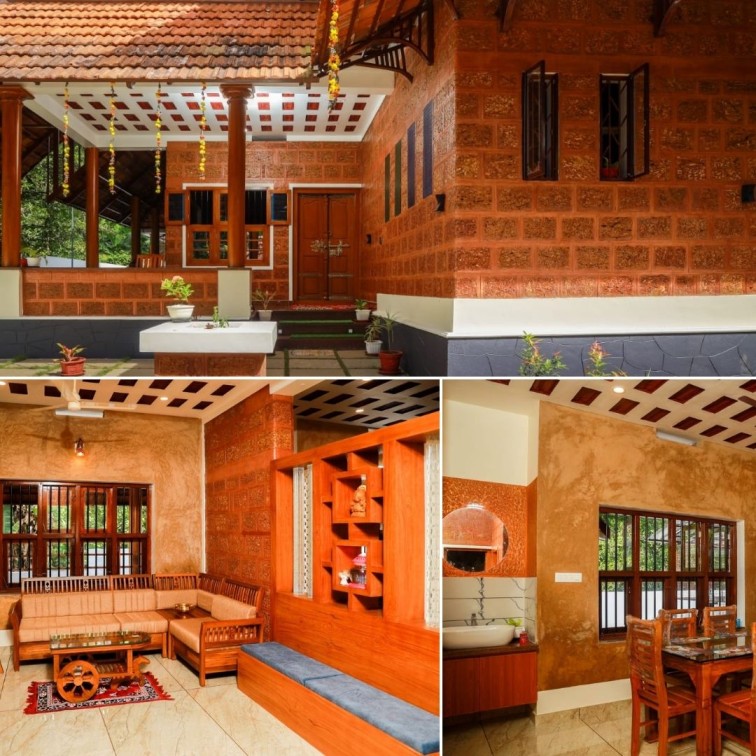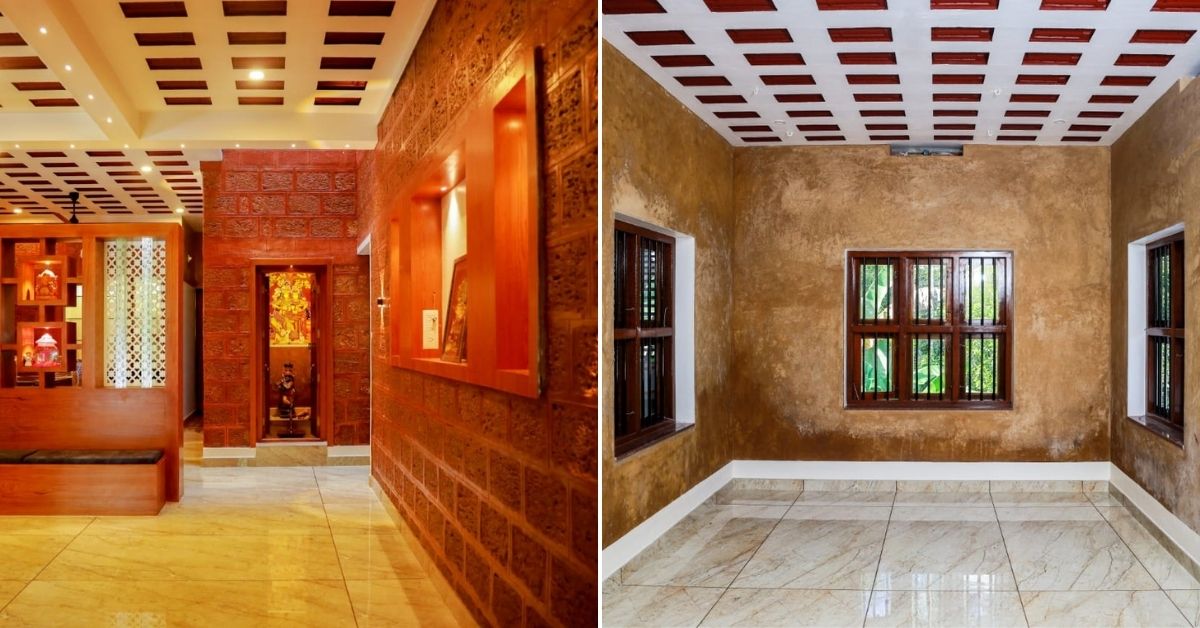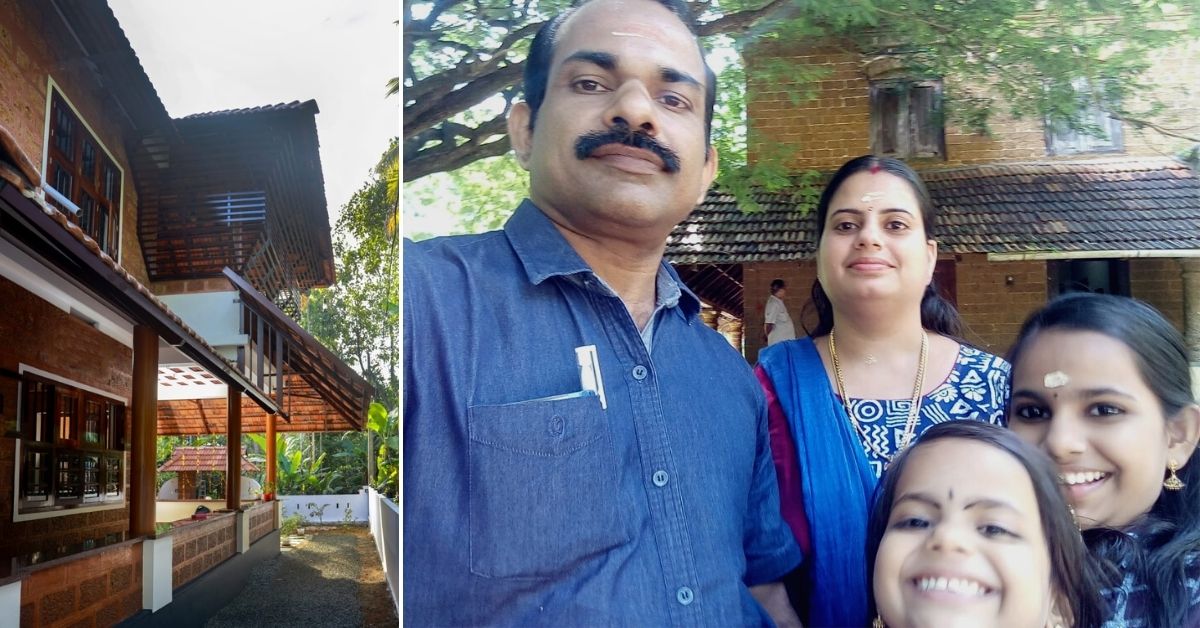When it came to building his new home, Dinesh Kumar, who works as a Sub-Engineer at the Thrissur corporation, was looking for something that invoked a sense of nostalgia.
“I’ve always wanted a house built using traditional architecture, like the houses I saw in my childhood, but with all the modern facilities. In ancient times, homes were built using eco-friendly materials and methods, which we wanted to try as well,” Dinesh tells The Better India.
For this, he approached Shantilal — a designer and engineer working for the Centre of Science and Technology for Rural Development (COSTFORD) — who had built several such eco-friendly projects.

The house, located close to Dinesh’s ancestral home in Meloor, has been designed based on Kerala’s traditional architecture using several eco-friendly and indigenous methods. Set in a total area of 2,700 sqft, the house has four bedrooms, a kitchen with an adjacent work area, a pooja room, a dining room, a balcony, and a multi utility space.
“The walls have been built using locally sourced laterite stones, which are naturally formed and have been a pivotal part of Kerala’s traditional architecture since ages,” says Shantilal. “We did not use cement or mortar. Instead, we have used a mixture of natural materials like sand and lime to bind the laterite stones. River sand and soil was completely avoided during the construction.” The compound walls were also built using laterite stones.
Shantilal says the plastering of the laterite walls has been done using a unique mixture of natural materials.
“We did mud plastering for most of the walls in the house. It was done by mixing several organic and natural materials with sand. We added rice husk, which adds strength as it has good fibre content. Other than that, we mixed jaggery, fenugreek, ‘kadukka’ (terminalia chebula) and lime, along with sand. All these materials add strength to the walls as a plaster and ‘kadukka’ helps in avoiding insects or termites. This kind of plastering gives the walls a natural texture and adds a traditional charm to the house.”

He notes, “But we did use cement plastering for a few places, like in the kitchen and bathrooms, as these are prone to moisture risk.”
Certain areas in the house have been left without plastering, which works as a beautiful design element. “We have used a water-based paint, which gives a glossy finish. The exterior of the house has been left without plastering, exposing the laterite stones,” adds Shantilal.
In addition to using natural materials in the construction, several sustainable and cost-effective techniques, including the filler slab, have been used while building the house.
Shantilal explains, “We used clay roof tiles in between the concrete. It reduces the load on the roof as well as the concrete volume and provides better thermal insulation. All the clay tiles were reused ones. The mud plastering, along with this method, helps in keeping the house naturally cool,” he says.

Dinesh says the house is cooler as compared to a normal concrete house built using conventional methods. “We feel the difference once we enter the house. We don’t use fans most of the time,” he says.
The house also has a light well — a courtyard in the centre of the house which has a grille and a glass ceiling on top. It helps provide sunlight through the day, Dinesh notes.
The balcony of the house is another eye-catching feature, inspired by Kerala’s traditional temple theatre structure. Shantilal says, “It’s designed in the model of a ‘koothambalam’, a traditional temple theatre for staging Koothu, an ancient ritualistic art form of Kerala. The balcony has a grille, which is made out of steel instead of wood. But we have coated it with paint that resembles wood to make it look authentic.” Dinesh says his wife and two children use the balcony as a study area and utility space.

“The windows, doors and other parts that required wood were all built using reused or old wood sourced from Mysore,” he adds.
The kitchen is spacious and set in a modern style with multi wood finish and an attached work area. The flooring of the house has been done using vitrified tiles.
The house has been built on a ‘pocket-friendly’ budget of Rs 35 lakh, Dinesh says. “I think the overall cost, including the raw materials and labour charges, is much cheaper than building a conventional concrete house of the same size,” he says.
Edited by Divya Sethu
No comments:
Post a Comment